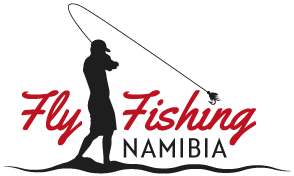
(Hydrocynus Vittatus)
The tigerfish is definitely one of the strongest fighting freshwater fish out there! Aggressive bites, acrobatic jumps, and teeth like a shark characterize this fish. The tigerfish is most commonly found in the Okavango and Zambezi rivers, but occasionally also in the Kwando River. It’s best to use rods rated for classes 8 or 9. With these strong rods, you can effectively cast larger streamers and withstand occasional winds. Using a sinking line is the most successful, but smaller tigerfish can also be caught with a floating line and poppers. Tigerfish can be caught throughout the year, with the most productive months being from March to May and from October to December.
(Serranochromis robustus)
belong to the cichlid family. Catching this fish is a real challenge, as they often stand quite deep and are usually well-protected among reeds and rushes. Once you get the hang of it and do catch one, you’re dealing with a very persistent fighter. Good populations of Nembwe can be found in the Kwando, Okavango, and Zambezi rivers. In the Zambezi, they can reach a weight of up to 3 kg! Rods rated 7, 8, and 9 are ideal. Of course, you'll need a sinking line and a few weighted streamers. The best time to catch Nembwe is between April and June, and then again from September to November.
gehört zu der Familie der Buntbarsche. Es ist eine echte Herausforderung diesen Fisch zu fangen, denn sie stehen ziemlich tief und meist gut geschützt zwischen Schilf und Riet. Hat man den Dreh raus, und fängt einen, hat man es hier mit einem sehr ausdauernden Kämpfer zu tun. Gute Nembwe Bestände findet man im Kwando, Okavango und Sambesi. Im Sambesi können sie über 3kg schwer werden! Ruten der Klasse 7, 8 und 9 sind ideal. Selbstverständlich benötigt man eine Sinkschnur und ein paar beschwerte Streamer. Am erfolgreichsten fängt man Nembwe zwischen April und Juni und dann wieder von September bis November.
(Serranochromis robustus)
belong to the cichlid family. Catching this fish is a real challenge, as they often stand quite deep and are usually well-protected among reeds and rushes. Once you get the hang of it and do catch one, you’re dealing with a very persistent fighter. Good populations of Nembwe can be found in the Kwando, Okavango, and Zambezi rivers. In the Zambezi, they can reach a weight of up to 3 kg! Rods rated 7, 8, and 9 are ideal. Of course, you'll need a sinking line and a few weighted streamers. The best time to catch Nembwe is between April and June, and then again from September to November.
(Oreochromis andersonii)
are mostly caught in quieter, weedy bays. This fish also belongs to the very large bream family. It's a very persistent fighter and quite beautiful at the same time! The best chance to catch a three-spot on the fly is in the Kwando and good populations are also found in the Zambezi (up to 4 kg!!). I prefer to use a 5-weight rod and a sink tip with a lightly weighted fly, being most successful between April and June and again from September to October.
(Hepsetus odoe)
gehört zu der Familie der Buntbarsche. Es ist eine echte Herausforderung diesen Fisch zu fangen, denn sie stehen ziemlich tief und meist gut geschützt zwischen Schilf und Riet. Hat man den Dreh raus, und fängt einen, hat man es hier mit einem sehr ausdauernden Kämpfer zu tun. Gute Nembwe Bestände findet man im Kwando, Okavango und Sambesi. Im Sambesi können sie über 3kg schwer werden! Ruten der Klasse 7, 8 und 9 sind ideal. Selbstverständlich benötigt man eine Sinkschnur und ein paar beschwerte Streamer. Am erfolgreichsten fängt man Nembwe zwischen April und Juni und dann wieder von September bis November.
gehört zu der Familie der Buntbarsche. Es ist eine echte Herausforderung diesen Fisch zu fangen, denn sie stehen ziemlich tief und meist gut geschützt zwischen Schilf und Riet. Hat man den Dreh raus, und fängt einen, hat man es hier mit einem sehr ausdauernden Kämpfer zu tun. Gute Nembwe Bestände findet man im Kwando, Okavango und Sambesi. Im Sambesi können sie über 3kg schwer werden! Ruten der Klasse 7, 8 und 9 sind ideal. Selbstverständlich benötigt man eine Sinkschnur und ein paar beschwerte Streamer. Am erfolgreichsten fängt man Nembwe zwischen April und Juni und dann wieder von September bis November.
(Clarias gariepienus und C. ngamensis)
can be found in all of our water systems. They can reach impressive sizes (up to 25 kg) and are not easy to catch on the fly. It’s best to use a 9-weight rod with a sinking line and heavy streamer. Casting upstream and retrieving deep along the bottom tends to be successful. However, landing an African catfish is no easy task. They are incredibly strong fighters that often like to disappear into the reeds. If you can avoid that, you’ll have a long and tough fight. Catfish can be caught successfully throughout the year.
(Clarias gariepienus und C. ngamensis)
can be found in all of our water systems. They can reach impressive sizes (up to 25 kg) and are not easy to catch on the fly. It’s best to use a 9-weight rod with a sinking line and heavy streamer. Casting upstream and retrieving deep along the bottom tends to be successful. However, landing an African catfish is no easy task. They are incredibly strong fighters that often like to disappear into the reeds. If you can avoid that, you’ll have a long and tough fight. Catfish can be caught successfully throughout the year.